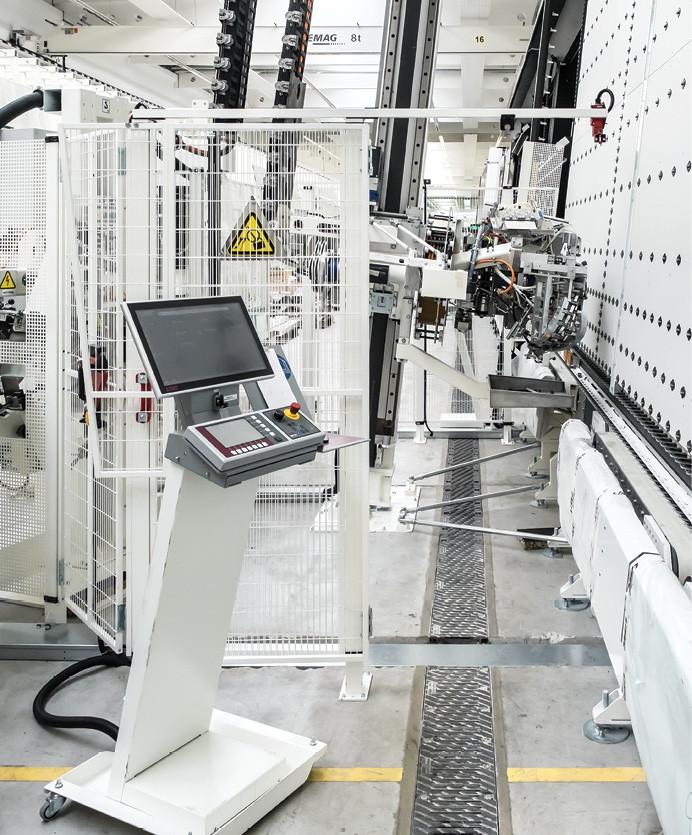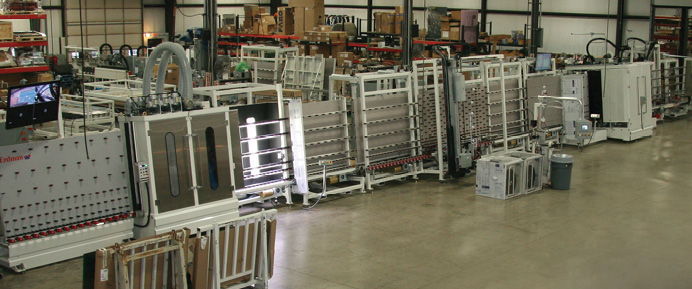
An automated insulating glass line at the Sedak, fabrication facilities. Photo courtesy of Quanex Building Products.
Shipping high-quality products is the lifeblood of any glass manufacturer, but how we work toward that goal has changed in recent years. Between a skilled labor shortage, the ongoing proliferation of automation and robotic technology for glass manufacturing, and other new trends, today’s manufacturing floor is in a constant state of flux.
The good news is that some of the fundamentals of quality manufacturing haven’t changed. And sticking to those fundamentals can help ensure a company sticks to its quality promise.
1. Watch key line processes.
The quality of finished glass units can be affected anywhere as they journey from the beginning of the line to the shipping trucks. But, quality is most heavily influenced by these four critical areas:
• Glass cutting. Maintaining a sharp, clean edge on a piece of glass is essential for the finished unit to live a long and reliable life. A clean edge helps ensure proper sealing; rough edges, burrs or chipping around the edges can compromise performance. Ensuring cutting wheels are sharp and properly maintained is one of the most critical components of quality.
• Glass washing. Perhaps even more critical than glass cutting is glass washing. A properly maintained glass washing station can help ensure a fabricator is eliminating contaminants that can interfere with both the performance and the aesthetics of a finished unit. Plant personnel should ensure they are using clean water, heated to the proper temperature. Take note that the brushes in the machine are making good contact with the glass itself. And double check that glass is fully dry before moving to the next stage of production.
• Spacer application. As spacer application increasingly becomes an automated process, it’s important to ensure that the system is properly set up and calibrated. Automation can elevate consistency and boost speed of production—but if the applicator is calibrated improperly, it just means the line is producing more units with the same defect. Even minor misapplications can have a big impact on end unit performance. Elsewhere, make sure the area is clean and free of debris. Rogue particles can interfere with application and ultimately edge seal durability.
• Secondary sealants. Here, plant personnel should ensure that the sealant material is at the correct temperature or mix ratio for proper performance. Poorly maintained gunning equipment will compromise the quality and integrity of the seal. Like the spacer application, check that the depth is correct and that application is accurate.
For line workers, proper training in each of these areas from the beginning is critical. Every team member needs to know what to do and what to look for. And remember, maintaining quality excellence is about continuing to do these things right day after day. So, set schedules. Regularly check calibrations. Maintain those glass cutters. And make each of these things a priority.
2. Build a culture of quality.
Knowing the mechanics of a quality product is one thing, but having the proper procedures put into practice on the shop floor every day is another. That’s because an organization’s commitment to quality is fundamentally a cultural issue—and it starts at the top and works its way down.
Consider a situation where an employee manning the secondary sealant station on an IG line notices a defect in the spacer application. It’s not an egregious error, but it’s noticeable, and it could very well turn into a performance issue or warranty claim down the line. But it’s busy season—orders are coming in fast and are expected to get out the door even faster. Keeping up with today’s production schedule is a priority.
In this instance, the employee is most likely to act in accordance with general expectations and culture on the shop floor. What’s more important? Ensuring a quality product, or keeping up with the schedule? If quality is top priority, the employee might feel the responsibility to halt the unit before it goes any further and work to correct the defect. Otherwise, he or she might just let the defective unit continue down the line to shipment.
Company leaders should consider what would happen in this instance on their shop floor.
Culture starts at the top. Everyone from the president to the factory foreman should be leading by example, helping to clearly demonstrate that quality means everything. And, perhaps most importantly, leadership must empower all line workers to do what’s necessary to maintain your organization’s commitment to quality.
A culture built around quality means that any line worker has the power to stop production if he or she notices a burred glass edge, a misapplied spacer or a sloppy secondary seal. If every employee is empowered to make the change, it’s far less likely defective units will make it all the way to the end of the line.

The automated from Erdman Automation. Photo courtesy of Quanex Building Products.
3. Leverage resources.
As the glass production floor changes, it’s important to keep up on the latest trends and techniques that can help maintain a commitment to quality. Take advantage of outside training opportunities, and work with suppliers that can offer expert perspectives on how to best work with those products.
But remember that at the end of the day, quality is in the hands of company leaders. It takes doing the essentials correctly, and it requires a cultural mindset that puts quality at the top of the priorities list. The business—and its reputation—depend on it.



